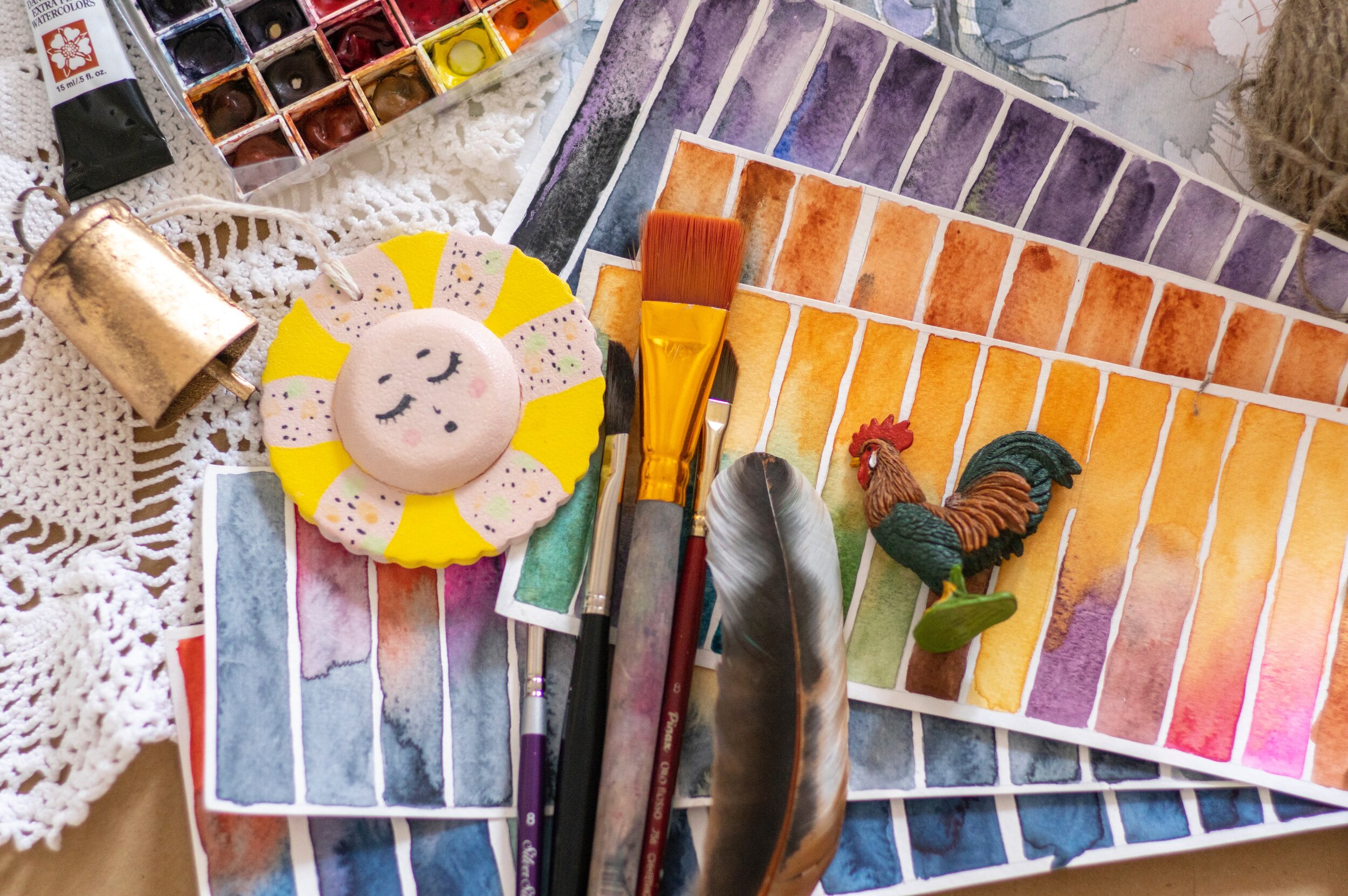
Art enables us to find ourselves and lose ourselves at the same time.
—Thomas Merton
Are you interested in trying new and creative ways to heal and express yourself? Have traditional healing methods failed you? Sarah Seraphina, of Nurtured Essence, can support a more enjoyable healing process through Artistic Expression.
You can create a more colorful future for yourself!
What is Art Therapy?
Art Therapy uses the creation of artwork to express oneself, and connect with your soul and inner world. Using art, we explore emotions and personal dynamics in order to understand both more fully. It not only helps clients understand themselves and their world better, but can also reduce stress, foster self-growth, positive regard for self and develop new skills, all accomplished through creating with art materials.
Making artwork is therapeutic in and of itself and can help reduce anxiety. It requires a level of mindfulness and allows individuals to distract themselves from life stressors. Making art allows us to connect to a Flow state and our deeper unconscious world, which can be so hard to achieve in today's world. This Flow State, allows us to tap into the unconscious part of the brain to shift and expand more easily. Art Therapy is facilitated by a professionally trained Art Therapist, and involves a supportive, guiding relationship in which collaboration is valued to address your challenges and the work you want to explore.
Why choose or try Art Therapy?
Talk Therapy can be challenging or intimidating to some people, especially those who are new to therapy, have cultural or personal beliefs that inhibit openness, or for people who struggle to understand and express their emotions. Language can sometimes fail to truly capture the human experience, and the emotional depth that is felt. Art allows us to hear and express the voice of our soul.
Art Therapy can be a non-threatening way to explore emotions and help you understand your emotional and spiritual experience more fully. In sessions, you will learn to express your feelings more freely and comfortably. You will learn to express yourself symbolically, as the Universe speaks in symbols. Concepts that are abstract and hard to understand, become more clear through using visual language, making life easier to navigate. In Art therapy session, you will learn to play in the Mystery of life and embrace more magic and flow into your life.
What if you are not an Artist or feel you aren’t artistic?
A person does not have to be an ‘artist’ to engage in Art Therapy. There is no right or wrong way to make art, which is explained in depth to the client early on to reduce any fear or shame a client may experience about creating artwork. Sessions are about expression and never the “final product.” Many clients have not created artwork in a long time and this can be a new and vulnerable experience for them. Art Therapists work with clients to help them feel safe and more comfortable in this new way of communicating, letting go of harsh self-judgements. Most clients have a lot of fun during art therapy sessions and groups, allowing themselves to revert to a more playful version of themselves.
The main goal is to create a supportive and safe space for self and soul expression. When our expression has been stunted and using your voice feels scary, art-making can be a great way to heal and empower your voice. An Art Therapist is trained in the therapeutic process, as well as in art materials and how to use specific materials to improve a client’s ability to express themselves. I will guide you, as you need, in creating what your heart desires.
What is an Art Therapy session like?
In an Art Therapy session, various art materials will be used such as paints, markers, colored pencils, beads, glue, yarn, and more. Art Therapists are trained to use numerous art materials and can teach clients how to use materials if they are unsure or would like to try something new to them. The focus of the creation of artwork is the more about the process, and not as much on the product, which is quite different than the purpose of creating art in other situations.
Sometimes we will explore a certain area or theme of your life, while other times you will be able to explore from a space of complete freedom and surrender!
What happens by creating artwork in an Art Therapy session?
In Art Therapy sessions, the goal is to improve the challenges or internal conflicts the person is being seen for, and a way to do this involves a process of exploring various aspects of the challenge or conflict. Creating art can help a person let down their defenses naturally, to allow the healing process to deepen and support more openness. Artwork is viewed as a reflection and extension of the creator. It is used as a tool to help you communicate more deeply with yourself, your soul, and the Art Therapist.
Creating artwork can also serve to externalize the conflict or challenge, giving them space to exist outside of the body. Often times, pain gets internalized, which can create great emotional weight and long-lasting mental health challenges. By externalizing the events or your feelings, the emotional weight and impact can become lighter and less overwhelming. This process can also help clients ‘let go’ by allowing a client to rip up, tear, and/or destroy the physical artwork as an act of strength and resilience, not allowing the subject of the artwork to have as much emotional significance or charge anymore.
Art Therapists do not use artwork to diagnose individuals or to assume an issue. Rather, Art Therapists use artwork as a visual to understand the individual’s perspective, and which questions to be curious about to facilitate deeper communication. For client’s having a visual item to point to and say, “this is what it feels like,” can help the Art therapist understand the client’s emotional experience more significantly.
Can anyone try Art Therapy? Is Art Therapy right for you?
Yes! Art Therapy is for everyone! It is used in a variety of settings including individual sessions, group sessions, in hospitals, wellness centers, private practice, and community centers. This modality can be used with a variety of populations such as Veterans, individuals with physical health complications, those with trauma, patients with eating disorders, and people with family conflicts, to name several.
I am a trained Art Therapist with many years of experience supporting people in experiencing more joy and fulfillment, while decreasing mental health struggles or life challenges, such as anxiety, depression, PTSD, grief, relationship challenges, and more…Sessions can be completed online or in person.




